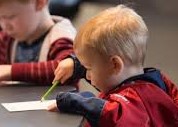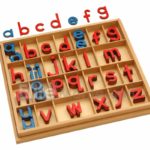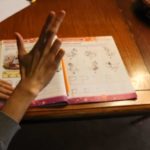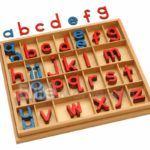 Children as young as 2 1/2 to 3 years old enjoy and benefit from playing with Key Words. So the examples given on the page in this website, Working Through The Steps With Key Words, can be used for both preschool and primary grade (K-3) children.
Children as young as 2 1/2 to 3 years old enjoy and benefit from playing with Key Words. So the examples given on the page in this website, Working Through The Steps With Key Words, can be used for both preschool and primary grade (K-3) children.
This page discusses how the basic strategies might be modified for use with preschoolers. So as we proceed here, we’ll be looking at adaptations you may want to consider as you work with an individual child. For since preschoolers develop rapidly — and in very different ways from one another — you will need to be the one to decide exactly how to proceed for each child with Key Words. And you can do that by considering the strategies described here as you see how the child responds.
So this page gives you some guidelines for deciding the best way to do that. It also suggests some answers related to the basic question you might get from others as you proceed. That is, “Why are you working with such a young child in this way?”
understanding the how of a “natural” approach — and the “why” of meaningful print
Before you begin with Key Words for a child of any age, it’s important to fully understand why and how this approach helps them. So first, it will help to read A Natural Approach To Learning. Having this foundation will help you make Key Words most effective for your child.
Then, following are a few things to keep in mind as you proceed.
What to Keep in Mind as you work with a very young child
A preschooler will go through the same 6 Steps as an older child, but as they go there are a few things you might need to modify for them. All decisions should be made to ensure they are comfortable as they go at their own pace and in their own way. So in no particular order, following are a few guidelines:
 1. A Key Word is the caption for a mind picture. Be sure the child is actually thinking about/envisioning the word you’re about to write. Give them plenty of time to talk about it.
1. A Key Word is the caption for a mind picture. Be sure the child is actually thinking about/envisioning the word you’re about to write. Give them plenty of time to talk about it.
2. Be very careful not to pressure the child in any way — it sets them up for failure. Pressure of any kind can be extremely destructive. Failure to do what you want/expect can cause them become confused and lose confidence with print.
3. In the beginning, the purpose of playing with Key Words is simply to help the child realize their own talk can be translated into print. So no skill development is involved at first.
4. Introducing the skills involved is very gradual and indirect — each child will try it at their own pace. Model in an “off hand” way — just as you did with speech. Keep it light, watch how your child responds and then gradually point out how you’re writing the word. Remember — you’re modeling, NOT directly teaching and then asking them to replicate what you do.
They’ll decide to try something, when they’re ready. Their natural inclination is to copy what they see you doing. Some will jump right in and try it — others will watch and simply absorb what you’re doing for awhile before they try it.
Take letter formation, for example. First you simply write the word. In a later stage, after you’ve written the entire Key word, you will model how to trace over the letters with your finger.
 But don’t expect them to do it themselves perfectly — if at all. Some may use their index finger, very carefully — just as you did. Another might just brush over the entire word at once.
But don’t expect them to do it themselves perfectly — if at all. Some may use their index finger, very carefully — just as you did. Another might just brush over the entire word at once.
Still  another may point to each letter — one at a time with the eraser end of a pencil, rather than their finger.
another may point to each letter — one at a time with the eraser end of a pencil, rather than their finger.
Accept whatever they’re doing. Just continue to point to the letters yourself each time you write their word. Say the names as they watch you write and again as you trace. Then later, see what happens when you ask them to try one letter. Eventually — when ready and in their own way — they will learn to form letters, based on what they see you doing.
Our job is to model — not prescribe. Think back to how each child begins speaking in their own way. It’s the same here. For instance, one of my daughters first spoke words, then phrases, and then full sentences — all remarkably clear. The other began babbling long “stories,” pausing as she went, as if speaking several “sentences.” These sounded like gibberish, but she was making her point. Only later did she translate her thoughts into words and sentences others could distinguish. So the two children came at it very differently, but the result was virtually the same.
5. Lack of motor skills shouldn’t stand in the child’s way. Instead of drawing what the word is about — as an  older child would do — a younger child can “play” with the words. For example, if the Key Word is their doll’s name, have them tell their doll about it and put the Word Card in the doll’s lap.
older child would do — a younger child can “play” with the words. For example, if the Key Word is their doll’s name, have them tell their doll about it and put the Word Card in the doll’s lap.
If it’s a toy of some kind — place the Word Card on/in that object for awhile. If the word is ice cream, have them put that Word Card in the freezer for awhile — joking that it will otherwise melt. Or if the Key Word is some kind of food, have them pretend to feed the Word Card to their teddy bear. In other words, have them focus on connecting the meaning of the Key Word to a real object or action. 

6. Lack of motor skills also shouldn’t stand in their way of copying their Key Words. Show the child how to use a Montessori-style moveable alphabet — laid out on a small rug. Or use a set of magnetic letters on a cookie sheet.
7. As your child grows, eventually check to see if they’re ready to create a Writing Book, with one page for each Key Word. If you’ve seen them at other times, trying to draw/paint, suggest they draw what their word is about. For them, at this point, that may  only mean drawing a line or painting a blob on their paper.
only mean drawing a line or painting a blob on their paper.
Accept that and listen to what they say about it. If the mark they’ve made really does — to them — represent their “mind picture” of the word, then make them a duplicate of their Word Card and help them paste it on their painting/drawing.
Or — you can simply write the word next to the blob, with an arrow pointing to it. (Notice if that makes sense to them. If so, do it again during the next session — if not, drop that idea.)
Once they have a few pages with the duplicate of their Key Word glued onto each page, or words written directly on them, make a “Writing Book “out of those few pages.
Use colored construction paper for the cover. Write their name and the date on it — you’ll find it a treasured item later. Sit with them as YOU read the book back to them each session. (Do not expect them to read it.)
8. When faced with a decision of how to proceed, think back to how you helped them learn to speak. You didn’t teach them how to speak — you casually modeled it for them in connection with “real life” meaning. And they took their own sweet time absorbing what they saw. Then they began doing it themselves — when they were ready.
The same is true of motor skills — you didn’t try to hurry them along from crawling to pulling themselves up to walk. Let them go at their own pace here, too.
9. If they don’t recognize a word the next day, just casually set it aside. But if they do, then place it on their metal Word Ring.
Have them “read” the words on their Word Ring at the beginning of each new session. Take off the ring any word they don’t know: One of the worst things you can do is keep words on their Ring they don’t immediately recognize. This undermines their confidence.
If that happens repeatedly, there’s no need to be concerned. They are just taking their time absorbing connections — in the same way some toddlers delay talking beyond what others do. Just take plenty of time talking and playing with each new word.
Eventually they will gather a collection they know. For you can be certain that any child who’s learned to speak will eventually learn to recognize words in print.
 10. Until a child is around 3 1/2 or 4 years old, let them hold a pencil or crayon in any way they choose. Then, see this activity called, “Alligator Mouth” that helps you introduce a
10. Until a child is around 3 1/2 or 4 years old, let them hold a pencil or crayon in any way they choose. Then, see this activity called, “Alligator Mouth” that helps you introduce a  child to the correct way to hold a pencil.
child to the correct way to hold a pencil.
11. Give only ONE Key Word a day. More can become confusing! (But the Key Word can be more than one, such as “birthday cake.”
Questions and responses to consider
As mentioned at the top of this page, you may be asked why you’re using Key Words with your child. Here are some questions and replies to help you think through your own response.
Why Start With Print During the Preschool Years? Because that’s when a child’s natural development “ripens” for working with print.
For instance, the preschool child who’s seen others writing, spontaneously begins to scribble, claiming they’ve written words. This is evidence the young child’s natural tendency is to move beyond speech and into print, once they’ve seen that as a possibility.

Further, Maria Montessori, provides more evidence of this. She insisted on letting a child’s interest be the guide for their work. For she believed that as a child’s brain developed physically, it reached specific times — “sensitive periods” — for learning a particular skill. And that during these times, the child would naturally be drawn toward working with materials/equipment that helped develop that skill.
She found this to be true with the ability to make distinctions in size, shape, number, etc. And when she offered them the use of a “moveable alphabet,” she found that children were interested in and able to build words from print at around 4 years old — some earlier.
Although my strategies for exposing a child to print are quite different from Montessori’s, I have found the same timing to be true. That is, a child who’s seen speech translated into print is naturally inclined to want to write, sometime during their mid to late preschool years.
Again, scribbling is evidence of that. A child who’s been immersed in a print-rich environment — where they see adults making lists, writing notes, etc. — will begin to make marks on paper, claiming they are writing words. This tells us they understand that print is used to convey ideas. And that they want — and are ready — to learn to do it themselves.
Why Key Words? Because Key Words are, by definition, captions for the child’s “mind pictures,” and as such, they support the child’s natural desire to communicate what’s on their mind.
Human beings are born with a strong desire to communicate what they have on their mind. The desire is so strong, our ancestors created alphabets to represent the words they had previously devised to convey their thoughts.
So, writing captions for our mind pictures is an innate tendency: Once a child can talk, they are drawn toward print, as it’s the next way for a human being to communicate their thoughts.
Further, new skills most readily attach to old learning and something of special interest. So the most powerful way for a child to learn to use print as a means of communication, is to work with meaningful print, i.e., print that represents the “mind-pictures” they have already translated into “talk.”
So a Key Word has strong meaning for the child, and this makes it a powerful magnet for attaching writing and reading skills — such as letter formation, phonics, and comprehension.
We Expose Our Preschoolers To the Alphabet — Isn’t That Enough? Playing with the alphabet is important, but it’s not enough.
Learning the alphabet song and playing with the names of the letters, as described in What about Phonics? develops a good foundation. But letters are just the bits and pieces we use to translate speech into print.
So limiting a young child’s exposure to the alphabet is only part of what we can do for them. They also need exposure to meaningful words in print to support them as they move along their natural path toward full communication.
Why Not Wait? Because having a rich, strong foundation will ensure a child’s success in school — and far beyond.
Armed with the understanding of what print is all about, along with some rudimentary skills, the child is ready to be successful with any reading program they encounter in the primary grades. This is very beneficial– especially if that program is not based on meaningful print.
Getting Started & Working with Key Words — at home or in a preschool classroom
Now that you have these things to keep in mind, you’re ready to adapt the basic Step-by-Step process of working with Key Words found on the page Working Through the Steps With Key Words.
join our facebook group and let us know how you’re doing
If you’re not already a member, please join the Facebook Group dedicated to using this “natural” approach to learning, Helping ALL Kids Write to Read: https://www.facebook.com/groups/450288968924872/
Then let me know how you’re doing!